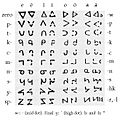Canadian Aboriginal syllabics facts for kids
Canadian syllabic writing, or simply syllabics, is an alphabet created by a Christian missionary to write down the languages of some of the First Nations of Canada. This one alphabet later became many alphabets.
Each letter represents a syllable. The letters look like triangles and curves. Different languages have some different letters to represent the sounds in their own language best.
By the late 19th century the Cree had achieved what may have been one of the highest literacy rates in the world.
Contents
History
James Evan was a Methodist missionary from England. He wanted to create an alphabet to teach the Cree and Ojibwe about Christianity. He got inspiration from the Devanagari alphabet from India.
Principles
Every consonant has the same shape. For example, the syllables that start with a "p" sound look like a V. To show that they have different vowels, the shapes are rotated. So "pe" would look like ᐯ whole "pa" would be ᐸ.
Final consonants
In some languages, words end in a final consonant, like the "t" in "cat." To show this, a small letter is added to the end of the word.
Diacritics
In some languages, diacritics are added to indicate things like vowel length.
Languages
Blackfoot
Carrier
Cree
Inuktitut
Syllabics is one of the official writing systems of Nunavut. That means that government forms in Inuktitut can be written either in the Latin alphabet (ABCs) or in syllabics.
Naskapi
Ojibwe
Slavey
Images for kids
-
A page from a prayer book written in the Carrier syllabics, an Athabascan adaptation of Canadian Aboriginal syllabic writing
-
Syllabics is a co-official script in the territory of Nunavut, and is used by the territorial government, as here.
See also
 In Spanish: Silabarios indígenas canadienses para niños
In Spanish: Silabarios indígenas canadienses para niños









